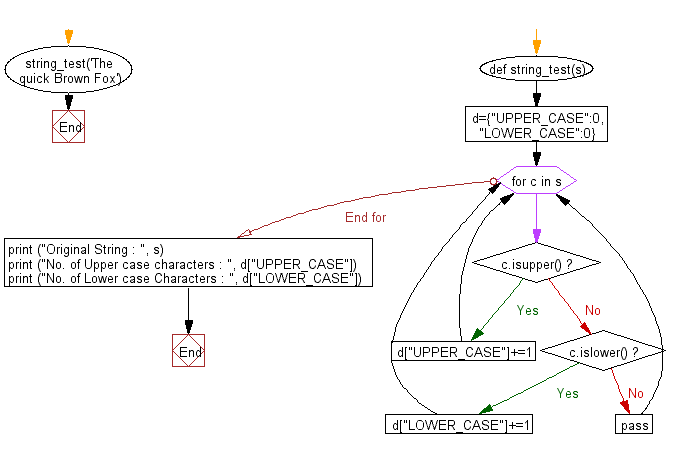Python Exercise: Calculate the number of upper / lower case letters in a string
Python Functions: Exercise-7 with Solution
Write a Python function that accepts a string and calculate the number of upper case letters and lower case letters.
Sample Solution:-
Python Code:
def string_test(s):
d={"UPPER_CASE":0, "LOWER_CASE":0}
for c in s:
if c.isupper():
d["UPPER_CASE"]+=1
elif c.islower():
d["LOWER_CASE"]+=1
else:
pass
print ("Original String : ", s)
print ("No. of Upper case characters : ", d["UPPER_CASE"])
print ("No. of Lower case Characters : ", d["LOWER_CASE"])
string_test('The quick Brown Fox')
Sample Output:
Original String : The quick Brow Fox No. of Upper case characters : 3 No. of Lower case Characters : 13
Pictorial presentation:
Flowchart:

Visualize Python code execution:
The following tool visualize what the computer is doing step-by-step as it executes the said program:
Python Code Editor:
Have another way to solve this solution? Contribute your code (and comments) through Disqus.
Previous: Write a Python function to check whether a number falls in a given range.
Next: Write a Python function that takes a list and returns a new list with unique elements of the first list.
What is the difficulty level of this exercise?
Test your Programming skills with w3resource's quiz.
Python: Tips of the Day
Find current directory and file's directory:
To get the full path to the directory a Python file is contained in, write this in that file:
import os dir_path = os.path.dirname(os.path.realpath(__file__))
(Note that the incantation above won't work if you've already used os.chdir() to change your current working directory, since the value of the __file__ constant is relative to the current working directory and is not changed by an os.chdir() call.)
To get the current working directory use
import os cwd = os.getcwd()
Documentation references for the modules, constants and functions used above:
- The os and os.path modules.
- The __file__ constant
- os.path.realpath(path) (returns "the canonical path of the specified filename, eliminating any symbolic links encountered in the path")
- os.path.dirname(path) (returns "the directory name of pathname path")
- os.getcwd() (returns "a string representing the current working directory")
- os.chdir(path) ("change the current working directory to path")
Ref: https://bit.ly/3fy0R6m
- New Content published on w3resource:
- HTML-CSS Practical: Exercises, Practice, Solution
- Java Regular Expression: Exercises, Practice, Solution
- Scala Programming Exercises, Practice, Solution
- Python Itertools exercises
- Python Numpy exercises
- Python GeoPy Package exercises
- Python Pandas exercises
- Python nltk exercises
- Python BeautifulSoup exercises
- Form Template
- Composer - PHP Package Manager
- PHPUnit - PHP Testing
- Laravel - PHP Framework
- Angular - JavaScript Framework
- Vue - JavaScript Framework
- Jest - JavaScript Testing Framework
